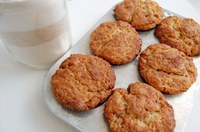Prairie Fare: Coffee Drinkers, Take Note
(Click an image below to view a high-resolution image that can be downloaded)
By Julie Garden-Robinson, Food and Nutrition Specialist
NDSU Extension Service
Do you start your day with a cup of coffee or two? Many people do.
I remember the “egg coffee” that accompanied the traditional Scandinavian church dinners in my hometown. A raw egg was added to the coffee grounds before the coffee was cooked in a big pot on the stove.
As a kid, I thought it was strange to waste a good egg on coffee. However, the effect can be explained by science. The albumin (egg white protein) pulls the impurities out of coffee and clarifies the coffee. The “egg coffee” was typically less bitter and had more caffeine.
In my experience, people of Scandinavian descent like super-powered coffee that isn’t bitter.
If you are a coffee drinker, you are not alone. Nearly two out of three people have coffee daily, according to the 2017 National Coffee Drinking Trends survey of 3,000 people.
In fact, coffee consumption has been on an upward trend since 2001, reaching 10.2 pounds of coffee beans per person annually.
Coffee drinkers often have a favorite “roast,” whether light, medium or dark roast. Roasting coffee beans enhances the flavor.
You might see “Arabica” or “Robusta” on coffee labels; these are types of coffee beans that have different flavor profiles and costs. Coffee beans often are grown in areas of Central and South America and Africa.
Light roasts are more acidic and have more antioxidants than dark roasts. Dark roast coffee often is described as “smoky” or even bitter or burned. Interestingly, light roast coffee typically is higher in caffeine than dark roast coffee.
How did this morning coffee tradition begin? According to legend and the National Coffee Association, a goat herder in Ethiopia noticed that when his animals ate berries from a tree, they became agitated. These peppy goats stayed restless all night.
Monks in a monastery began consuming the berries in a beverage and were able to stay awake during evening prayer. Long before the advent of Facebook, news about coffee began circling the globe.
Coffee not only energizes us with its caffeine content, but it also is part of social activities such as coffee clubs.
Even “decaf” has a little caffeine but far less than regular coffee. The amount of caffeine varies widely depending on the method of brewing and the type of coffee. An “average” cup of regular coffee has about 100 to 150 milligrams of caffeine, compared with 5 to 10 milligrams in a cup of decaffeinated coffee.
Coffee even may have some health benefits and some potential risks. Like most other foods and beverages, moderation is key.
A moderate amount of coffee is typically three or four cups (24 to 32 ounces) of coffee daily. Be sure you know how much coffee your favorite cup holds. A large mug of coffee may account for the entire “moderate” amount of coffee. Too much coffee can interrupt sleep, and cause migraine headaches, nervousness and rapid heartbeat, among other symptoms.
Coffee can lead to temporary increases in blood pressure among those with high blood pressure. Those with uncontrolled blood pressure should avoid large amounts of coffee.
Coffee is high in antioxidant compounds, which may help regulate blood sugar levels. Some research has shown that regular coffee consumption may help prevent Parkinson’s disease, a nervous system disorder.
Too much coffee may be linked with bone loss and, potentially, fractures. We all need weight-bearing exercise, calcium, vitamin D and other nutrients to maintain the strength of our bones. People younger than age 50 need about 1,000 milligrams of calcium per day and those older than 50 need 1,200 milligrams per day.
Is coffee linked to cancer? According to a recent ruling, California coffee companies must warn consumers of a chemical (acrylamide) present in small amounts in coffee that may be linked to cancer, according to animal studies. However, the American Cancer Society has said that no cancer link has been found in humans. Stay tuned as this information evolves and keep moderation in mind.
Here’s a tasty muffin recipe to enjoy with a cup of your favorite coffee.
Snickerdoodle Muffins
1 c. butter or margarine, softened
1 1/4 c. Greek yogurt (plain, nonfat)
2 eggs
2 tsp. vanilla extract
1 c. sugar
3/4 tsp. baking soda
3/4 tsp. baking powder
3/4 tsp. cream of tartar
3/4 tsp. ground nutmeg
1/2 tsp. ground cinnamon
1 1/2 c. all-purpose white flour
3/4 c. whole-wheat flour
5 Tbsp. additional sugar and 1 Tbsp. ground cinnamon mixed together to sprinkle on top of muffins (1/2 Tbsp. per muffin)
Preheat oven to 350 degrees. Combine wet ingredients (softened butter or margarine, Greek yogurt, eggs and vanilla) in one bowl. Combine dry ingredients in a separate bowl. Fold the dry ingredients into the wet ingredients until dry ingredients are mixed. Batter may be lumpy. Grease muffin tins or use paper liners; fill about three-fourths full. Stir together additional sugar and cinnamon and sprinkle 1/2 Tbsp. on each muffin. Bake for 20 to 22 minutes or until they are golden brown.
Makes 12 muffins. Each muffin has 330 calories, 16 grams (g) fat, 6 g protein, 41 g carbohydrate, 1 g fiber and 270 milligrams sodium.
(Julie Garden-Robinson, Ph.D., R.D., L.R.D., is a North Dakota State University Extension Service food and nutrition specialist and professor in the Department of Health, Nutrition and Exercise Sciences. Follow her on Twitter @jgardenrobinson)
NDSU Agriculture Communication - April 12, 2018
| Source: | Julie Garden-Robinson, 701-231-7187, julie.garden-robinson@ndsu.edu |
|---|---|
| Editor: | Ellen Crawford, 701-231-5391, ellen.crawford@ndsu.edu |



